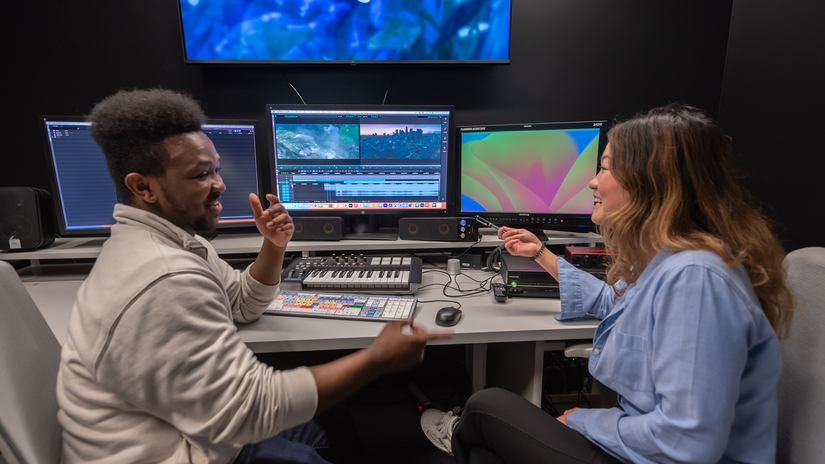FASHN 13 | Draping I3 unitsTransfer: CSU
This course covers the principles of draping and the ability to develop a pattern in three-dimensional form, opening new ways of designing and creating and recognizing the qualities of a well-designed garment. |
|---|---|
FASHN 14 | Draping II3 unitsTransfer: CSU
This course is a continuation of Fashion 13 and deals with more complex and original designs for draping. Students will learn how to analyze and interpret complicated designs by means of draping and gain enough experience and speed to create and develop more advanced designs. |
FASHN 15 | Ethnic Fashion3 unitsTransfer: CSU Apparel worn as national dress by people all over the world is surveyed. The origins and functions of clothing in different cultures are examined. Creative designing is inspired by ethnic costumes. |
FASHN 16 | Pattern Grading2 unitsTransfer: CSU
Grading is the process of proportionally increasing or decreasing the production pieces according to set measurements for each clothing classification (Women’s Junior Petite, Junior, Misses, Half-sizes). This is done without changing or losing the style proportions which are part of the design concept while still retaining the original lines and style of the garment. Students are introduced to and become familiar with a computer program used for grading in the fashion industry, and with the logic and rules that apply to pattern grading. |
FASHN 17 | Apparel Collection Design and Production3 unitsTransfer: CSU
This course will provide industry-oriented application of design skill sets for developing apparel groups and a final collection ready for production. Costing and production methods, line organization, sourcing suitable fabrics, cost sheets, production patterns and sample making will be covered. One final collection will be produced for fashion show presentation. |
FASHN 18 | Computer Aided Fashion Design and Merchandising2 unitsTransfer: CSU
Computer-assisted applications are used as tools to design and create original and innovative work for fashion marketing or fashion design. This is an introductory course requiring basic computer skills. Students will need access to a computer and the Adobe Creative Suite software. |
FASHN 19 | Fashion Marketing3 unitsTransfer: CSU
This course will provide students with an understanding of the psychology, sociology and cultural influences that affect consumer fashion purchasing behavior. The interaction of aspects of the fashion business, including planning, pricing, promotion and distribution, will be covered. Students will learn about how to reach targeted customers locally or globally, with accuracy of products, prices, promotions and channels of distribution. |
FASHN 2 | Color Analysis3 unitsTransfer: CSU This course is an exploration of color theory and elements of design with emphasis on the expertise of color mixing and creative color combinations. Theory is applied to textile, fashion design, and fashion merchandising. |
FASHN 20 | Fashion Styling and Visual Presentation3 unitsTransfer: CSU
This course involves the study and exploration of styling fashion visual presentations, including editorial, ad campaigns, and digital retail environmental display. Students will research promotion techniques and methodology used for window and catalog display, exhibitions, look books, and graphic collateral used in various market categories in order to create a styling concept portfolio. |
FASHN 21 | Digital Fashion Portfolio2 unitsTransfer: CSU
This advanced course addresses the skills necessary to produce a well-organized and thoroughly planned portfolio, both virtual and printed, to be presented on job interviews. Students will be expected to have completed a body of work, prior to taking this course, from which to build a portfolio. Students should bring prior and current design projects for portfolio content. |
FASHN 3 | Apparel Construction3 unitsTransfer: CSU This course is an introduction to basic sewing techniques of costume and manufacturing apparel and provides familiarization with the tools used in the fashion industry. Development of fundamental skills and terminology of clothing construction. Emphasis is on interrelationship of fabric, fiber, design and construction techniques. This course is required of all Fashion Design and Merchandising majors. |
FASHN 5 | Fashion Buying3 unitsTransfer: CSU This is an introductory course in fashion buying to acquaint the students with the life of a buyer that includes considerations and practices of an executive or middle manager. The buyer’s position includes responsibilities such as making evaluations and maintaining standards that are complete and constant. This course will also present an awareness of quality effect of stocking merchandise and knowing and effectively practicing what to buy, when to buy, and how much to buy. |
FASHN 6A | Pattern Drafting and Design2 unitsTransfer: CSU
This course is a study of the basic pattern drafting techniques of the apparel industry and the transfer of a design to a flat pattern. Students learn to design and make their own patterns. |
FASHN 6B | Pattern Drafting and Design Intermediate3 unitsTransfer: CSU
This course is a continuation of Fashion 6A with emphasis on more advanced and complex design creations in harmony with the current trends. |
FASHN 7 | Fashion Textiles3 unitsTransfer: UC, CSU A detailed study of textiles from fiber to finished fabric is covered in this course including identifications of fiber types, construction, printing, dyeing, and finishes of natural/man-made fabrics. Emphasis is on fabric design, principles of patterns, and methods of textile decoration. |
FASHN 8 | History of Fashion Design3 unitsTransfer: CSU This survey of fashion of the Western world introduces historic dress as an inspiration and a design resource for students of fashion design and fashion buying and merchandising. The evolution silhouette and the cut and construction of men’s and women’s garments are analyzed using slides of paintings, drawings, sculpture and historic costume. Contemporary examples in fashion are compared to their historic sources. |
FASHN 88A | Independent Studies in Fashion1 unitTransfer: CSU Please see “Independent Studies” section. |
FASHN 88B | Independent Studies in Fashion2 unitsTransfer: CSU Please see “Independent Studies” section. |
FASHN 88C | Independent Studies in Fashion3 unitsTransfer: CSU Please see “Independent Studies” section. |
FASHN 90A | Fashion Internship1 unitTransfer: CSU Please see “Internships” section. |




